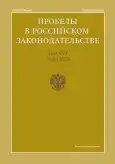Проблемные вопросы определения некоторых признаков организованной преступной группы
- Авторы: Гунькин Ю.И.1
-
Учреждения:
- Следственный комитет Российской Федерации по Ростовской области
- Выпуск: Том 16, № 8 (2023)
- Страницы: 192-197
- Раздел: Уголовно-правовые науки
- URL: https://journals.rcsi.science/2072-3164/article/view/251417
- EDN: https://elibrary.ru/PGAUQQ
- ID: 251417
Цитировать
Аннотация
Цель исследования. В статье рассматриваются проблемные вопросы определения некоторых признаков организованной преступной группы. Анализируются факторы, позволяющие отличать формы организованной преступной группы от иных форм соучастия, и проводить надлежащую квалификацию преступлений, связанных с деятельность организованных преступных групп. Целью исследования является выявление сущностных признаков организованной и их определение, что имеет существенное значение для надлежащей квалификации.
Выводы. В результате проведенного исследования автор приходит к выводу, что в уголовном законе и судебной практике понятие организованной группы и преступного сообщества (преступной организации) отсутствует, в связи с чем целесообразно дать легальное определение указанным формам соучастия. Рассматривая вопросы количественного состава организованных преступных групп, автор полагает, что количество участников организованной группы должно быть не менее двух, а преступного сообщества (преступной организации) - не менее четырех. Исследуя понятие такого признака организованной преступной группы как устойчивость, автор полагает возможным понимать под таковым длительность существования соответствующего преступного объединения, обусловленного наличием стабильного взаимодействия его участников.
Полный текст
Открыть статью на сайте журналаОб авторах
Юрий Иванович Гунькин
Следственный комитет Российской Федерации по Ростовской области
Автор, ответственный за переписку.
Email: yuriy_gunkin@list.ru
SPIN-код: 2613-8984
старший следователь-криминалист отдела криминалистики следственного управления
Россия, Ростов-на-ДонуСписок литературы
- Авдеев В.А., Авдеева О.А. Правовая политика в сфере противодействия групповой и организованной преступности в контексте реализации норм международного права // Международное уголовное право и международная юстиция. 2022. № 6. С. 2 - 5.
- Агапов П. Критерии разграничения организованной группы и преступного сообщества // Законность, 2007, № 5. С. 23-25.
- Капитонова О.С. Понятие ОПГ в постановлениях Верховного Суда Российской Федерации // Апробация. – 2014. № 8. С. 88.
- Матейкович М.С. Об уголовной ответственности за преступления в сфере незаконного оборота наркотиков, совершенные организованными группами и преступными сообществами // Российская юстиция. 2015. № 12. С. 25 - 27.
- Мондохонов А.Н. Понятие, признаки и виды преступных объединений // Законность. 2020. № 3. С. 50 - 54.
- Оценочные признаки в Уголовном кодексе Российской Федерации: научное и судебное толкование: научно-практическое пособие / Ю.И. Антонов, В.Б. Боровиков, А.В. Галахова и др.; под ред. А.В. Галаховой. М.: Норма, 2014. 736 с.
- Сердюкова К.А. Преступное сообщество (преступная организация) как объединение организованных групп // Законность. 2016. № 9. С. 46 - 50.
- Трузян Э.В. Организованная преступная группа по российскому уголовному законодательству: понятие, виды, ответственность.: Дис. ... канд. юрид. наук: 12.00.08: М., 2018. 201 c.
- Ермакова Т.Н. Банда и преступное сообщество (преступная организация) как форма соучастия: сравнительно-правовой анализ. Автореферат диссертации на соискание ученой степени кандидата юридических наук. Москва. 2009 г. 29 с.
- Букалерова Л.А., Нестеров С.В. – К вопросу о формах соучастия в преступлениях, предусмотренных ст.ст.208, 209, 210 УК РФ // Полицейская и следственная деятельность. – 2016. - № 4. – с. 86-89.
Дополнительные файлы








